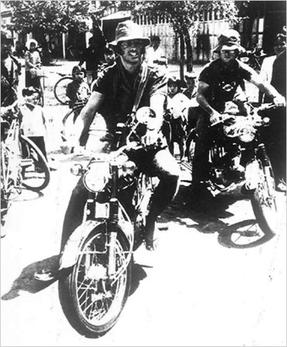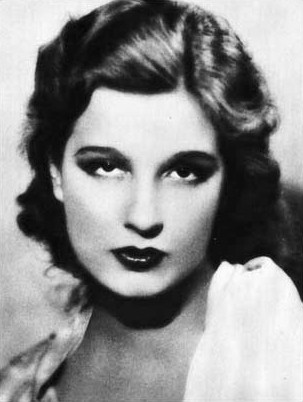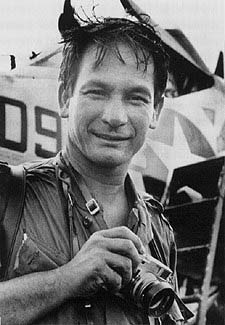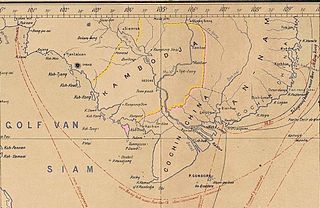
Sean Leslie Flynn was an American actor and freelance photojournalist best known for his coverage of the Vietnam War.

The Cambodian Civil War was a civil war in Cambodia fought between the forces of the Communist Party of Kampuchea against the government forces of the Kingdom of Cambodia and, after October 1970, the Khmer Republic, which had succeeded the kingdom.

Lili Damita was a French-American actress and singer who appeared in 33 films between 1922 and 1937.

Timothy John Page was a British photographer. He was noted for the photos he took of the Vietnam War, and was later based in Brisbane, Australia.
Neil Brian Davis was an Australian combat cameraman who was recognised for his work as a photojournalist during the Vietnam War and other conflicts in the region. He was killed in Bangkok on 9 September 1985, while filming a minor Thai coup attempt.

François Bizot is a French anthropologist. While working as a conservationist in Cambodia, he was held captive by the Khmer Rouge for several months. He was released after being found innocent of spying charges, becoming the only Westerner to survive imprisonment by the Khmer Rouge.

Henri Huet was a French war photographer, noted for his work covering the Vietnam War for the Associated Press (AP).

Al Rockoff is an American photojournalist made famous by his coverage of the Vietnam War and of the Khmer Rouge takeover of Phnom Penh, Cambodia's capital. He was portrayed in the Academy Award-winning film The Killing Fields by actor John Malkovich, although he has never been happy with this portrayal. Rockoff was born in Pawtucket, Rhode Island and is of half Russian and half Irish ancestry. After enlisting in the Navy while under age, he subsequently became an Army photographer in South Vietnam.
The Indochina Media Memorial Foundation (IMMF) was founded in 1991 by British photographer Tim Page, who survived multiple wounds while covering the Vietnam War. The foundation was set up to honor the memory of the more than 320 journalists from all sides who died while covering the conflicts in Vietnam, Laos and Cambodia from 1945 to 1975. Its other main aim was to assist colleagues in a region that was emerging from decades of war, poverty and isolation-remembering the dead by helping the living.

Kate Webb was a New Zealand-born Australian war correspondent for UPI and Agence France-Presse. She earned a reputation for dogged and fearless reporting throughout the Vietnam War, and at one point she was held prisoner for weeks by North Vietnamese troops. After the war, she continued to report from global hotspots including Iraq during the Gulf War.

The Cambodian Usurpation of 1811–1812 was when an army from Siam (Thailand) supported Ang Snguon after he overthrew his brother Ang Chan; but Vietnam sent a large army to help reinstate Ang Chan at Phnom Penh.
The World of Charlie Company is a one-hour film documentary produced by CBS News in 1970 that shows what life was like in the jungles of South Vietnam for a rifle company of American soldiers fighting regular units of the North Vietnamese People's Army of Vietnam (PAVN).
Perry Deane Young was a journalist, author, playwright, historian, and professional gardener. He was the author of Two of the Missing, about fellow journalists Sean Flynn and Dana Stone, who went missing during the Vietnam War and whose fates remain unknown, and the co-author of The David Kopay Story, a biography of 1970's professional football player David Kopay, who revealed in 1975 that he was gay.

General Dien Del was a prominent Cambodian military officer and later, politician. He directed combat operations in Cambodia, first as a general in the Army of the Khmer Republic (1970–1975) and then as a leader of Khmer People's National Liberation Front (KPNLF) guerrilla forces fighting against the Vietnamese occupation (1979–1992). Following Vietnam's withdrawal from Cambodia in 1990, he presided over the demobilization of the KPNLF's armed forces in February 1992. In 1998 he was elected to the National Legislative Assembly as a member of FUNCINPEC. He spent the last fifteen years of his career as advisor to the Cambodian government.

Marc Filloux was a French journalist based in Vientiane, Laos for Agence France-Presse who disappeared and was killed along with his translator and girlfriend in Cambodia when he attempted to be the first to obtain an interview with the Khmer Rouge's leaders during the Cambodian Civil War.

Chas Gerretsen is a Dutch-born war photographer, photojournalist and film advertising photographer. His photographs of armed conflicts, Hollywood films and Celebrity Portraits have been published in major magazines.

John Laurence is an American television correspondent, author, print reporter and documentary filmmaker. He is known for his work on the air at CBS News, London correspondent for ABC News, documentary work for PBS and CBS, and his book and magazine writing. He won the George Polk Memorial Award of the Overseas Press Club of America for "best reporting in any medium requiring exceptional courage and enterprise abroad" for his coverage of the Vietnam War in 1970.
Hugh David Scott Greenway is an American journalist who has worked as a foreign affairs correspondent for Time Life, The Washington Post, and The Boston Globe. Greenway has covered conflicts in Vietnam, Laos, Cambodia, Afghanistan, Lebanon, Iraq, Pakistan, Burma, El Salvador, Nicaragua, Bosnia, and Croatia. His writing has also appeared in The New York Times, The New Yorker, The New York Review of Books, The Atlantic, the Columbia Journalism Review, and la Repubblica. Greenway is currently a columnist for Foreign Affairs and a member of the Council on Foreign Relations.
The Vietnamese invasions of Cambodia refers to the period of Cambodian history, between 1813 and 1845, when the Kingdom of Cambodia was invaded by the Vietnamese Nguyễn dynasty three times, and a brief period from 1834 to 1841 when Cambodia was part of Tây Thành province in Vietnam, undertaken by Vietnamese emperors Gia Long and Minh Mạng. The first invasion that took place in 1811–1813 put Cambodia as Vietnam's client kingdom. The second invasion in 1833–1834 made Cambodia a de facto Vietnamese province. Minh Mạng's harsh rule of the Cambodians finally ended after he died in early 1841, an event which coincided with a Cambodian rebellion, and both which triggered a Siamese intervention in 1842. The unsuccessful third invasion of 1845 resulted in the independence of Cambodia. Siam and Vietnam signed a peace treaty in 1847, allowing Cambodia to reassert its independence in 1848.












